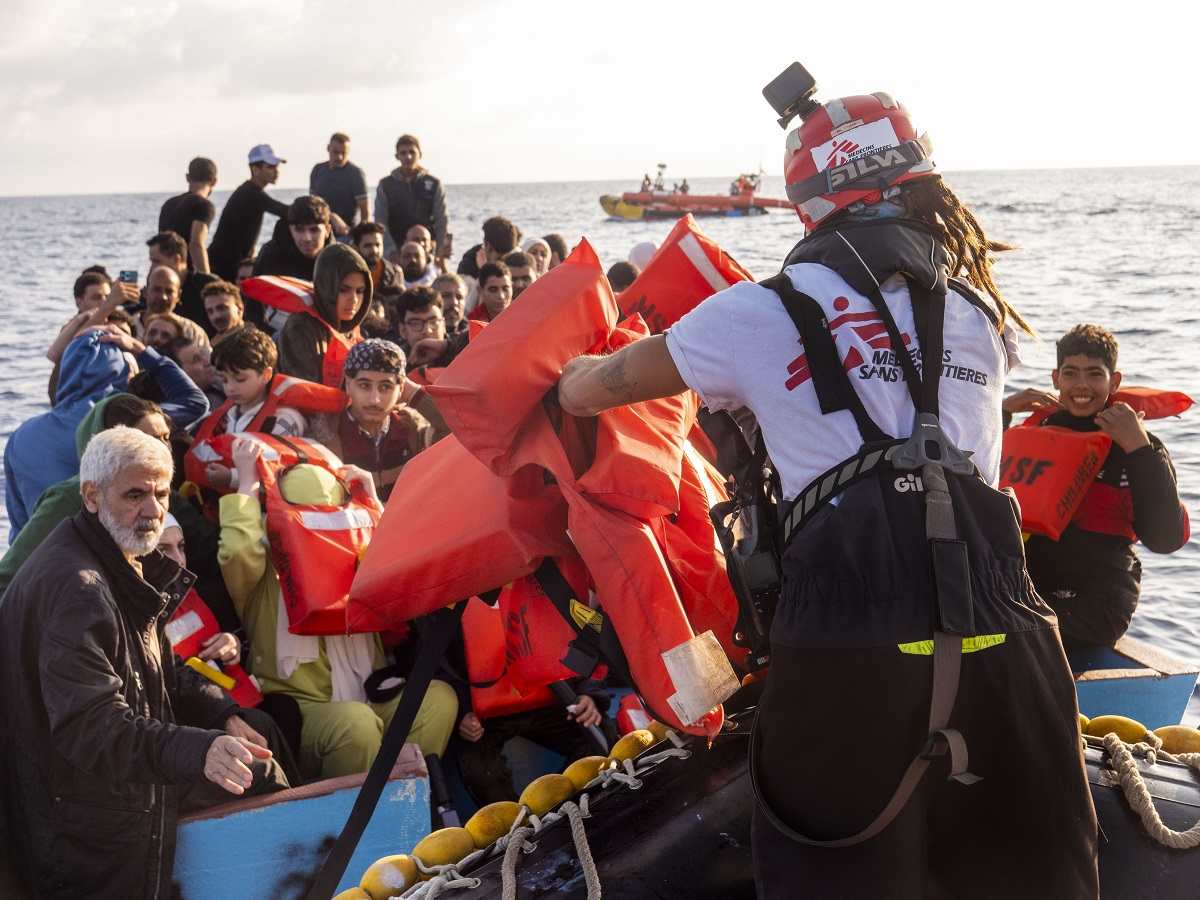
Migrants are rescued from the sea some 30 miles off Libya by the members of the humanitarian ship Geo Barents, Friday, Oct. 6, 2023. Badly advised by relatives and friends, misled by insufficient official information or poor translation services, many can end up in legal limbo for years, cut off from any government aid.
15:25 JST, November 16, 2023
SALERNO, Italy (AP) — Less than 24 hours after setting foot on the pier of a southern Italian port, 60 people who’d survived a perilous boat journey from Libya were served with expulsion orders.
Some came from Bangladesh, others from Syria and Egypt. They’d been at sea for 10 hours in two dangerously overcrowded boats, carrying 258 people in all, when they were picked up by a rescue ship operated by the humanitarian group Doctors Without Borders, 30 miles (50 kilometers) from the Libyan coast, on Oct. 6.
Once on dry ground in Salerno, just south of Naples, they were taken to a migrant processing center and asked to sign papers. Now they gathered in front of the train station, tired and bewildered.
Did you know what you were signing? asked a volunteer from the Catholic charity Caritas. “No, no,” they replied in unison.
Did somebody ask you if you want to apply for international protection? the volunteer asked. Again they replied, “No.”
The situation is common for newly arrived migrants and asylum-seekers on European shores. Badly advised by relatives and friends, misled by insufficient official information or poor translation services, many make hasty and often irreversible decisions. They can end up in legal limbo for years, cut off from any government aid.
So far this year, more than 236,000 people have entered European Union borders irregularly, according to International Organization for Migration figures, up 60% from the same time last year. The vast majority arrived in Italy by boat.
Despite decades of efforts to reform it, Europe’s asylum system remains messy and ineffective. Attitudes toward migrants and refugees are hardening throughout the continent, in a difficult balance between protecting borders and respecting human rights.
He did not apply for asylum, officials wrote in Italian, English and Arabic on Mohammed’s crumpled expulsion sheet. The 23-year-old Syrian man, who asked for his full identity not to be revealed, clutched the paper as he sat on a bench in a shelter run by volunteers, in Salerno, his eyes red with lack of sleep.
People arriving from Syria are almost always given asylum, but Mohammed decided not to apply.
Italy doesn’t want him; he doesn’t want to be in Italy. He has siblings in Germany, so that’s where he plans to go.
I want to stay in Germany, said Mohammed. “If I was to apply for asylum in Italy, they would send me back here if I am caught in Germany.”
The Italian authorities gave the rescue ship he was on permission to dock in Salerno, three days’ sailing away from the open waters of the Mediterranean. Italy has failed to stop the rescue ships from picking up migrants but it forces them to use up fuel and sailing days to reach distant ports.
Those who disembarked in Salerno on Oct. 9 included migrants from Syria, Egypt, Bangladesh, South Sudan, Ghana and Ivory Coast. They were taken to a processing center where they were photographed and fingerprinted.
Neither Bengali nor Arabic translators were present when they were questioned by border officials, The Associated Press confirmed in official documents and with local authorities.
Migrants often lack information about their rights, in part due to the absence of interpreters during the identification process. According to a study by the International Rescue Committee, an NGO, only 17% of the migrants arriving in Italy receive adequate information about their rights.
When they heard the newly arrived migrants were to be expelled, lawyers and volunteers working for Caritas rushed to Salerno train station in the early hours of the morning to provide food, water and basic legal advice.
We informed them about their right to appeal the expulsion order, explained Antonio Bonifacio, one of the volunteers at Caritas, “but only Bangladeshi (migrants) and some Egyptians filed the appeal with our lawyers, while all the Syrians left by train as soon as possible to try to reach their destinations in Northern Europe, as they were afraid of being tracked down and getting stuck in Italy.”
Among the Syrians planning to head north was a 33-year-old woman from Damascus. This was her third attempt to reach Europe by sea after her brother, a student who opposed the regime of President Bashar al-Assad, was killed in prison.
The AP had no means of verifying her account, which included a second attempt at sea involving a wooden boat with around 350 passengers that began to sink shortly after departing from Tobruk, in northeastern Libya.
She said she swam to the beach. After a brief moment of safety, “I was kept in a Libyan detention center for a week without access to a shower, with my clothing drenched in salt and vomit,” she said.
Now I just want to reach my brother in Germany.
Under European rules, known as the Dublin Regulation, migrants are supposed to apply for asylum in the first EU member state they enter. If they travel to another EU country and get picked up by the authorities, they’re supposed to be sent back to their country of arrival or first registration.
This places a huge burden on the countries that have received the most arrivals by sea, such as Greece, Italy, Malta and Spain.
However, in December 2022, Italy unilaterally suspended transfers of migrants and asylum-seekers back to its territory. This means that if Mohammed goes to Germany and gets caught, he can’t be sent back to Italy. Instead, he would have to start a new asylum application in Germany.
Premier Georgia Meloni, Italy’s first far-right leader since World War II, has acknowledged that migration has been the biggest challenge of her first year in government. In April, her government passed a new fast-track migration procedure, meant to resolve the majority of cases within 28 days.
Those who apply for asylum are held in detention centers until their case can be processed. Those who don’t apply, or whose visa application is rejected at the first stage, are served with expulsion orders and given seven days to leave the country. The backlog of asylum applications currently stands at 82,000.
In theory, anyone found on Italian soil after the expiry date of their order risks up to 18 months in a migrant detention center before being expelled. In practice, the detention centers are full, and Italy has no repatriation agreements with many of the countries the migrants come from, leaving of those expelled in a loop of lack of documents and repeated detentions.
Gabindo, a 35-year-old Bangladeshi man, was on the same boat as Mohammed. It was the second time he’d been caught by the Italian authorities without a visa. On the first page of his deportation order, it said, “Detention centers for repatriation are full.”
Gabindo, who asked for his full name not to be published for fears of further worsening his legal status in Italy, was allowed to go free. The system was seemingly relying on his goodwill to self-repatriate.
Italy’s new fast-track process is causing concern that applicants are being triaged based on their nationality, according to a list of countries that Italian authorities deem safe, such as Morocco, Ivory Coast, or Nigeria, whose nationals would on average see their asylum requests denied.
While the United Nations refugee agency, UNHCR, agreed in a recent statement that “stronger and faster procedures at the borders” are necessary, it also stressed that people should be given the opportunity to flag an individual situation of insecurity despite their country of origin.
Maurizio Veglio, a lawyer with the Association for Juridical Studies on Immigration, called the new fast-track procedures “an attack on the right to receive asylum.” He said that “compressing the time for the evaluation will surely affect the quality of the screening.”
Despite the discouraging messages from the Italian government, some migrants decide to stay. Alei Wuch Alei, a 21-year-old from South Sudan, spent five years on the move after leaving his home province of Warrap. He arrived in Salerno on the MSF rescue boat and has applied for asylum.
I crossed the desert from Sudan to Libya and I tried three times to cross the sea, he said. “Once I spent three days adrift and I was beaten several times in a Libyan detention center. Now I dream to continue studying and to become a doctor.”
Outsourcing will remain a key pillar of EU migration policy, with the bloc building partnerships with African and Mideast countries to help stop people from leaving. Those countries deemed safe that do not take back their citizens could find it more difficult to secure European visas.
Albania recently agreed to temporarily shelter thousands of migrants while Italy reviews their requests seeking asylum in Italy, up to 36,000 a year. The deal has caused some concerns from UNHCR on the guarantee of human rights and refugees protection standards.
But for all the chaos and confusion, for some of those reaching Europe there’s a happy ending. Jahdh al-Ali, a 58-year-old Syrian refugee from Daraa, was also on the MSF rescue ship. She applied for asylum in Italy but her preferred destination was France.
I’d like to go and live with my daughter, al-Ali said in Salerno. “She lives in France: she has a baby there and I wish I could stay there next to my daughter and do something for French people.”
"News Services" POPULAR ARTICLE
-

American Playwright Jeremy O. Harris Arrested in Japan on Alleged Drug Smuggling
-

Japan’s Nikkei Stock Average as JGB Yields, Yen Rise on Rate-Hike Bets
-

Japan’s Nikkei Stock Average Licks Wounds after Selloff Sparked by BOJ Hike Bets (UPDATE 1)
-

Japan’s Nikkei Stock Average Buoyed by Stable Yen; SoftBank’s Slide Caps Gains (UPDATE 1)
-

Japanese Bond Yields Zoom, Stocks Slide as Rate Hike Looms
JN ACCESS RANKING
-

Keidanren Chairman Yoshinobu Tsutsui Visits Kashiwazaki-Kariwa Nuclear Power Plant; Inspects New Emergency Safety System
-

Tokyo Economic Security Forum to Hold Inaugural Meeting Amid Tense Global Environment
-

Imports of Rare Earths from China Facing Delays, May Be Caused by Deterioration of Japan-China Relations
-

University of Tokyo Professor Discusses Japanese Economic Security in Interview Ahead of Forum
-

Japan Pulls out of Vietnam Nuclear Project, Complicating Hanoi’s Power Plans
























